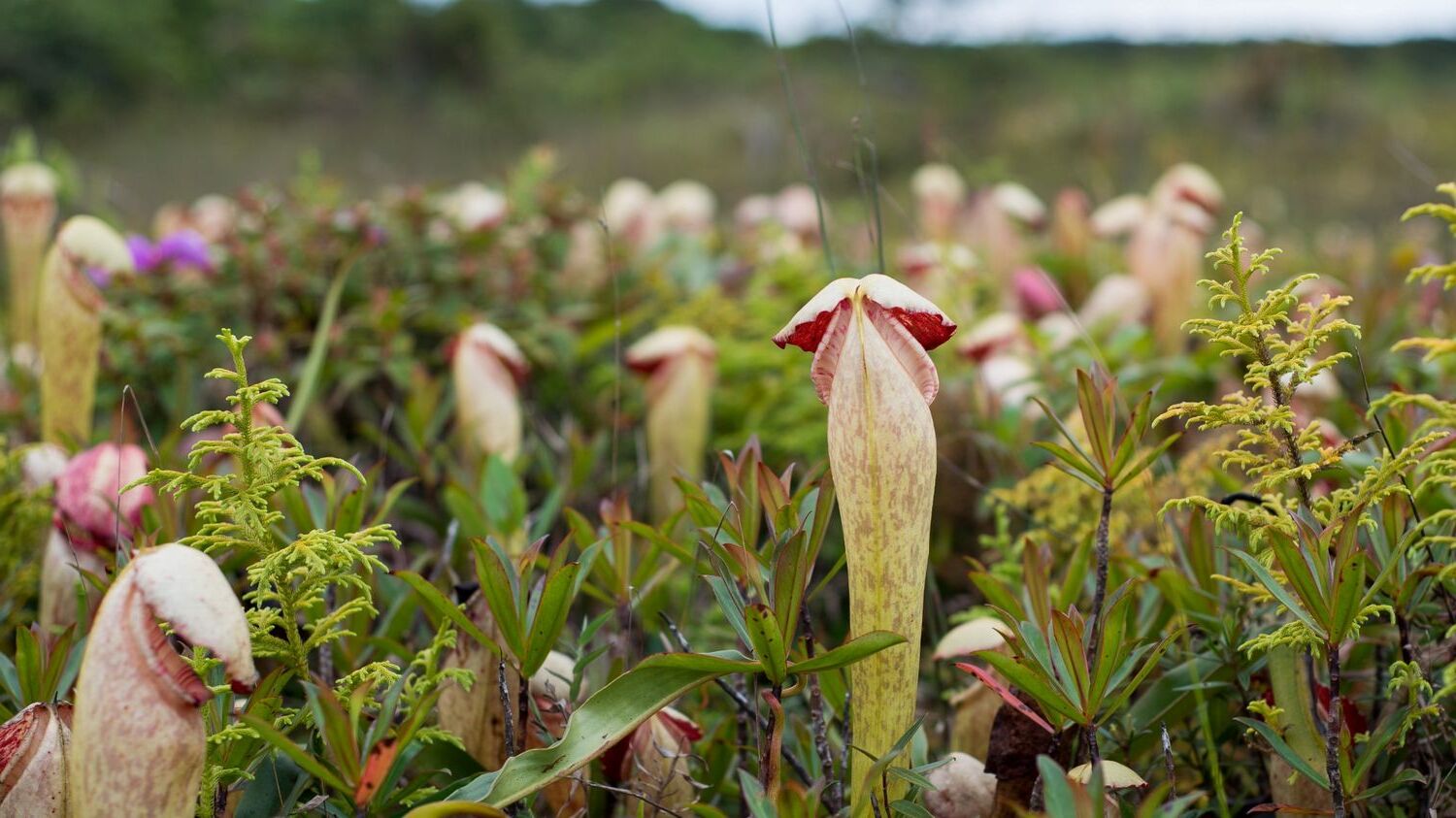
Nepenthes bokorensis is a fascinating carnivorous plant native to Cambodia. Known for its unique pitcher-shaped leaves, this plant has evolved to trap and digest insects, providing a nutrient boost in nutrient-poor soils. Did you know that Nepenthes bokorensis can grow up to 1.5 meters tall? These plants thrive in high-altitude environments, often found on the Bokor Plateau. Their pitchers can hold up to 500 milliliters of water, creating a deadly trap for unsuspecting prey. Interestingly, the plant's nectar attracts insects, luring them into the pitcher where they meet their fate. This species is not just a marvel of nature but also a subject of scientific interest due to its unique adaptations. Want to learn more about this incredible plant? Keep reading to uncover 35 amazing facts about Nepenthes bokorensis!
Key Takeaways:
- Nepenthes Bokorensis, a unique pitcher plant from Cambodia, has large, slippery pitchers that trap insects for nutrients, but its habitat is threatened by deforestation and climate change.
- This fascinating plant, with its medicinal folklore and ecological importance, faces challenges in research and conservation due to its remote habitat and limited resources.
What is Nepenthes Bokorensis?
Nepenthes bokorensis is a fascinating species of tropical pitcher plant. Found in Cambodia, this plant has unique characteristics that make it stand out among other carnivorous plants. Let's dive into some intriguing facts about this remarkable species.
-
Nepenthes bokorensis is native to the Bokor National Park in Cambodia, which is where it gets its name.
-
This species was officially described in 2009 by François Mey, a French botanist.
-
The plant thrives in high-altitude environments, typically found at elevations between 800 and 1,100 meters.
-
Nepenthes bokorensis prefers humid, tropical climates with plenty of rainfall.
-
The pitchers of this plant can grow up to 25 centimeters in height, making them quite large compared to other pitcher plants.
Unique Characteristics of Nepenthes Bokorensis
Nepenthes bokorensis has several unique features that set it apart from other pitcher plants. These characteristics not only make it interesting to botanists but also to plant enthusiasts.
-
The pitchers have a distinctive, elongated shape with a narrow waist and a flared opening.
-
The interior of the pitchers is lined with slippery, waxy scales that make it difficult for insects to escape once they fall in.
-
The plant produces two types of pitchers: lower pitchers that grow near the ground and upper pitchers that form on climbing stems.
-
The lower pitchers are usually larger and more robust, while the upper pitchers are more slender and elongated.
-
The coloration of the pitchers can vary, ranging from green to reddish-brown, often with striking speckles or stripes.
How Nepenthes Bokorensis Captures Its Prey
Like other pitcher plants, Nepenthes bokorensis has evolved to capture and digest insects. This adaptation allows it to thrive in nutrient-poor soils where other plants might struggle.
-
The plant lures insects with nectar secreted around the rim of the pitcher.
-
Once an insect lands on the rim, it often slips on the waxy surface and falls into the pitcher.
-
The interior of the pitcher contains digestive enzymes that break down the insect's body, allowing the plant to absorb essential nutrients.
-
The plant primarily targets ants, flies, and other small insects, but it can occasionally trap larger prey like spiders or small frogs.
-
The digestion process can take several days, after which the plant absorbs the nutrients and discards the indigestible parts.
Conservation Status of Nepenthes Bokorensis
The conservation status of Nepenthes bokorensis is a topic of concern for botanists and environmentalists. Due to its limited range and specific habitat requirements, the species faces several threats.
-
Habitat loss due to deforestation and land development poses a significant risk to the plant's survival.
-
Climate change and shifting weather patterns can also impact the delicate balance of the plant's ecosystem.
-
Illegal collection and trade of rare plants have further threatened the population of Nepenthes bokorensis.
-
Conservation efforts are underway to protect the plant's natural habitat and promote sustainable practices.
-
Bokor National Park, where the plant is found, has been designated as a protected area to help preserve its unique flora and fauna.
Interesting Tidbits About Nepenthes Bokorensis
Beyond its biological and ecological significance, Nepenthes bokorensis has some fascinating tidbits that make it even more intriguing.
-
The plant's pitchers can hold up to 500 milliliters of liquid, making them effective traps for capturing prey.
-
Some local communities believe that the plant has medicinal properties and use it in traditional remedies.
-
Nepenthes bokorensis is often cultivated by plant enthusiasts and collectors, who appreciate its unique appearance and carnivorous nature.
-
The plant's name, "bokorensis," is derived from Mount Bokor, a prominent mountain in Cambodia where the species was first discovered.
-
Nepenthes bokorensis is part of the Nepenthaceae family, which includes over 170 species of pitcher plants.
The Role of Nepenthes Bokorensis in Its Ecosystem
Nepenthes bokorensis plays a crucial role in its ecosystem, contributing to the balance of its natural habitat. Its presence impacts various aspects of the environment.
-
The plant helps control insect populations by capturing and digesting them.
-
It provides a habitat for certain species of insects and small animals that live in or around the pitchers.
-
The plant's nectar serves as a food source for some insects, which in turn pollinate the flowers.
-
The decomposition of captured prey enriches the soil with nutrients, benefiting other plants in the vicinity.
-
Nepenthes bokorensis contributes to the overall biodiversity of its habitat, supporting a wide range of species.
Challenges in Studying Nepenthes Bokorensis
Studying Nepenthes bokorensis presents several challenges for botanists and researchers. These difficulties highlight the need for continued research and conservation efforts.
-
The plant's remote and high-altitude habitat makes it difficult to access and study in the wild.
-
Limited funding and resources for botanical research can hinder efforts to understand and protect the species.
-
The plant's specific habitat requirements make it challenging to cultivate and study in controlled environments.
-
Climate change and environmental degradation can impact the plant's natural habitat, complicating research efforts.
-
Collaboration between local communities, researchers, and conservation organizations is essential for the successful study and preservation of Nepenthes bokorensis.
The Fascinating World of Nepenthes Bokorensis
Nepenthes Bokorensis, a unique carnivorous plant, has captured the interest of botanists and nature enthusiasts alike. Found in Cambodia's Bokor National Park, this plant thrives in nutrient-poor soils by trapping and digesting insects. Its striking pitcher-shaped leaves, vibrant colors, and intricate patterns make it a standout in the plant kingdom.
Understanding its habitat, growth patterns, and survival strategies offers valuable insights into biodiversity and ecosystem dynamics. The plant's ability to adapt to harsh environments highlights nature's resilience and ingenuity. Whether you're a seasoned botanist or just curious about unique plants, Nepenthes Bokorensis provides a window into the wonders of nature.
By learning about such extraordinary species, we can better appreciate the delicate balance of our ecosystems and the importance of conservation efforts. So next time you think of carnivorous plants, remember the fascinating Nepenthes Bokorensis and its remarkable story.
Frequently Asked Questions
Was this page helpful?
Our commitment to delivering trustworthy and engaging content is at the heart of what we do. Each fact on our site is contributed by real users like you, bringing a wealth of diverse insights and information. To ensure the highest standards of accuracy and reliability, our dedicated editors meticulously review each submission. This process guarantees that the facts we share are not only fascinating but also credible. Trust in our commitment to quality and authenticity as you explore and learn with us.


